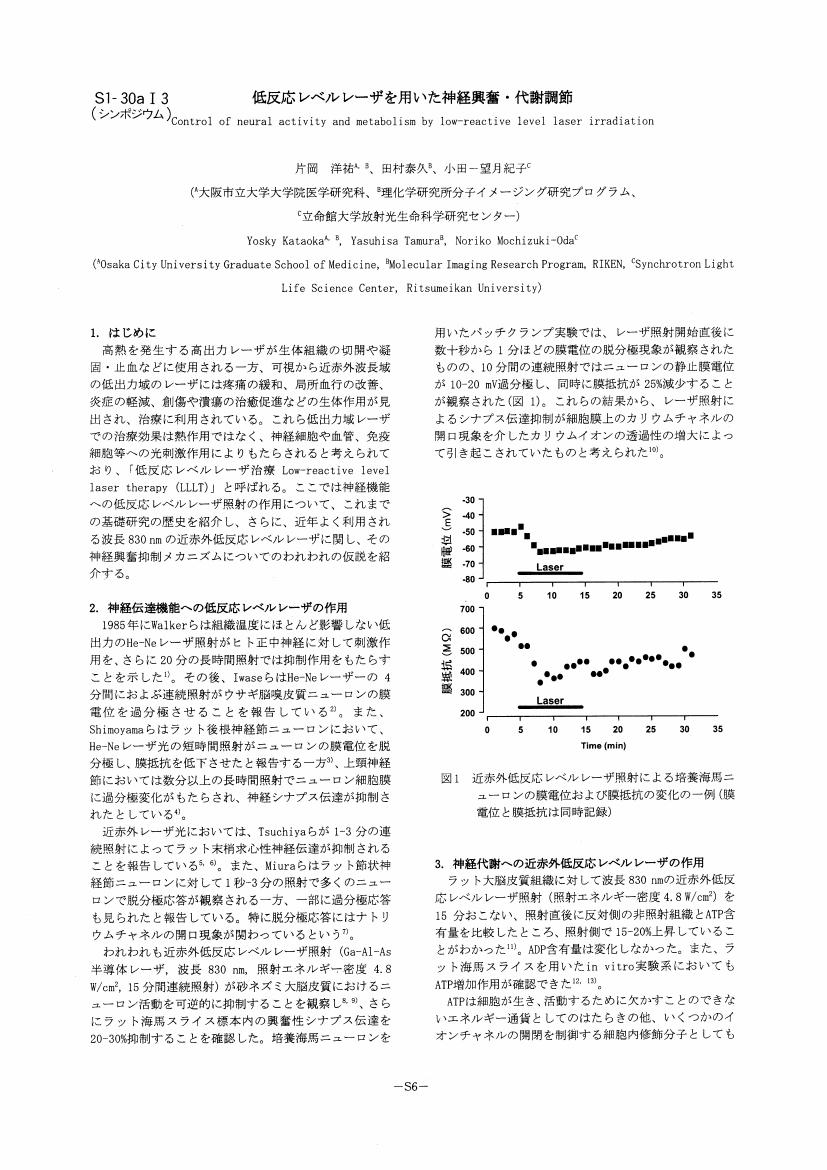71 0 0 0 OA 近赤外レーザー照射による中枢神経機能制御
- 著者
- 片岡 洋祐 小田 紀子 望月 紀子 田村 泰久 山田 久夫
- 出版者
- 一般社団法人 レーザー学会
- 雑誌
- レーザー研究 (ISSN:03870200)
- 巻号頁・発行日
- vol.33, no.Supplement, pp.256-257, 2005-01-20 (Released:2014-03-26)
- 参考文献数
- 6
60 0 0 0 OA 低反応レベルレーザを用いた神経興奮・代謝調節
- 著者
- 片岡 洋祐 田村 泰久 望月 紀子 小田 紀子
- 出版者
- 一般社団法人 レーザー学会
- 雑誌
- レーザー研究 (ISSN:03870200)
- 巻号頁・発行日
- vol.36, no.Supplement, pp.S6-S7, 2008-01-30 (Released:2014-03-26)
- 参考文献数
- 14
18 0 0 0 OA レーザーによる神経機能調節とそのメカニズム
- 著者
- 片岡 洋祐
- 出版者
- 日本レーザー歯学会
- 雑誌
- 日本レーザー歯学会誌 (ISSN:09177450)
- 巻号頁・発行日
- vol.18, no.2, pp.93-96, 2007-10-01 (Released:2010-10-21)
- 参考文献数
- 24
Low-reactive level laser therapy has been applied for pain relief and improvement of local circulation, and hasbeen popular in many clinical fields. The cellular mechanism, however, has not been fully clarified. Some basic researches indicated that laser suppresses neural activity by direct action on the nervous tissue, and affects membrane potential and the input membrane resistance of neurons. Using low-reactive level laser irradiation with a near-infrared diode laser (continuouswave; wavelength, 830 nm; power density, 1-5 W/cm2), we achieved inactivation of excitatory synaptic transmission in the central nervous system of rodents. In the study using cultured rat hippocampal neurons, the laser irradiation induced hyperpolarization of the membrane potential and reduction of input membrane resistance, suggesting that the laser suppressed synaptictransmission by opening potassium channels in the cells. The laser irradiation increased the content of adenosine triphosphate (ATP) in the tissue. Furthermore, laser-induced suppression of synaptic transmission was attenuated under application of anATP-sensitive potassium channel opener. These observations indicate that suppression of neural activity by low-reactive levellaser irradiation in a near-infrared wavelength is brought about by opening of ATP-sensitive potassium channels by the increasein intracellular ATP level. Recently, it was demonstrated that laser irradiation suppressed synaptic transmission morepotently in hippocampal slices at a low ATP content. This may contribute to the clinical phenomenon that more potent effectsof low-reactive level laser irradiation are often seen on tissue under pathological states than physiological states.
- 著者
- 片岡 洋祐
- 出版者
- 公益社団法人 日本ビタミン学会
- 雑誌
- ビタミン (ISSN:0006386X)
- 巻号頁・発行日
- vol.90, no.4, pp.167-168, 2016 (Released:2017-12-26)
5 0 0 0 OA PET を用いた分子イメージング
- 著者
- 片岡 洋祐 渡辺 恭良
- 出版者
- Japan Society for Laser Surgery and Medicine
- 雑誌
- 日本レーザー医学会誌 (ISSN:02886200)
- 巻号頁・発行日
- vol.37, no.4, pp.473-478, 2017-01-15 (Released:2017-10-10)
- 参考文献数
- 11
- 被引用文献数
- 2
PET(陽電子放射断層撮影)は短半減期の放射性核種を化学的に導入した分子や薬剤(PET 分子プローブ)を生体へ投与し,放出されるガンマ線を体外で検出して画像化する技術である.したがって,X 線CT やMRI などが生体の構造を映し出すことに対し,PET は生体中の分子の分布や動態を可視化できることが特徴である.ここではPET の原理に加え,最も頻繁に使用される[18F]FDG を用いたPET の基礎研究,さらに,共通の分子プローブを用いた動物からヒトまでの最新の脳内神経炎症イメージング研究を紹介する.
3 0 0 0 プラズマ照射による中枢神経組織・細胞制御と機能再生
- 著者
- 片岡 洋祐
- 出版者
- 国立研究開発法人理化学研究所
- 雑誌
- 新学術領域研究(研究領域提案型)
- 巻号頁・発行日
- 2015-04-01
プラズマは光・電子・イオン・ラジカルの集団で、生体分子や組織と相互作用することが知られ、近年、癌治療や止血等に応用されようとしている。しかしながら、中枢神経組織へのプラズマの作用については報告が少なく、その応用の可能性は未知数である。本研究ではラットの中枢神経組織を対象に大気圧プラズマを照射し、神経伝達や組織の可塑性・再生機能へ及ぼす効果を検討した。特に、大脳新皮質へ大気圧プラズマを直接照射して、その後の組織学的な変化を観察した結果、照射3日から7日後にかけて、大脳皮質の照射部位近傍において、グリア前駆細胞マーカーを発現する細胞やミクログリアマーカーを発現する細胞などの複数の細胞種が層状に配列する特徴的な組織構築が形成され、組織の再生を誘導する再生面を形成することを発見した。また、照射後3日をピークに未分化細胞マーカーを発現する細胞も多数出現し、活発に増殖していることも見出した。そこで、こうした大脳皮質組織を採取し、培養試験系にてスフェア形成実験を実施し、多分化能を有する幹細胞が誘導されているかを検討した。その結果、プラズマ照射組織からは大型のスフェアが多数形成され、分化誘導するとニューロン・オリゴデンドロサイト・アストロサイトなどの中枢神経細胞が得られることもわかった。大気圧プラズマ照射技術は、今後、中枢神経組織をはじめ、生体のさまざまな組織の再生医療に応用展開できる可能性が見出された。
1 0 0 0 テアニン高含有緑茶抹摂取による高齢者の認知症予防効果
- 著者
- 片岡 洋祐 宇都宮 一泰 金原 紀章
- 出版者
- 日本未病システム学会
- 雑誌
- 日本未病システム学会雑誌 (ISSN:13475541)
- 巻号頁・発行日
- vol.15, no.1, pp.17-23, 2009
- 著者
- 山野 恵美 片岡 洋祐
- 出版者
- 医学書院
- 雑誌
- Brain and nerve (ISSN:18816096)
- 巻号頁・発行日
- vol.70, no.1, pp.27-34, 2018-01
1 0 0 0 プラズマの中枢神経組織への作用の解明
- 著者
- 片岡 洋祐
- 出版者
- 独立行政法人理化学研究所
- 雑誌
- 新学術領域研究(研究領域提案型)
- 巻号頁・発行日
- 2013-04-01
プラズマは光・荷電粒子・ラジカル等からなり、その医療応用においてはさまざまな可能性が示唆されているものの、確立された理論に基づく医療技術あるいは装置は未だ確立されていない。特に、中枢神経組織へのプラズマの作用についてはほとんど研究が進められておらず、その作用や医療応用の可能性すら議論できる状況にない。そこで、ラット大脳皮質を対象に大気圧プラズマ照射がどのような作用を有するかについて、光組織酸化反応との相違点から明らかにしてきた。具体的には、光組織酸化の場合、一過性のシナプス伝達抑制が引き起こされるが、プラズマ照射ではそういった神経伝達への影響は小さかった。また、強い光組織酸化反応では周辺細胞の脱分極現象が引き金となって片側大脳皮質にSpreading depressionが発生し、グリア前駆細胞やミクログリアが一斉に増殖を開始する一方、プラズマ照射ではSpreading depressionを発生させることなく多数の増殖細胞を出現させることを発見した。こうしたプラズマによる細胞増殖の誘導と組織再生との関係について分子メカニズムを解明し、さらに、再生誘導に最適なプラズマ照射条件を見出した。


